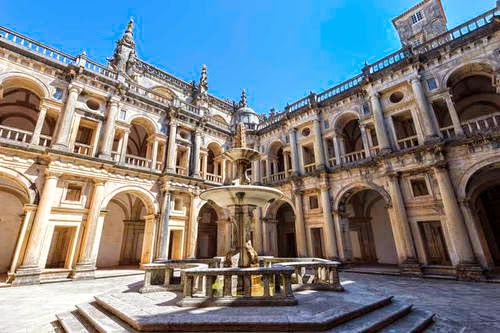Convent of Christ in Tomar
Originally designed as a monument symbolizing the Reconquest, the Convent of the Knights Templar of Tomar (transferred in 1344 to the Knights of the Order of Christ) came to symbolize just the opposite during the Manueline period – the opening up of Portugal to other civilizations.
Originally designed as a monument symbolizing the Reconquest, the Convent of the Knights Templar of Tomar (transferred in 1344 to the Knights of the Order of Christ) came to symbolize just the opposite during the Manueline period – the opening up of Portugal to other civilizations.
Long Description
The Convent of Tomar, originally conceived as a symbolic monument of the Reconquest, became, from the Manueline period, an inverse symbol: that of the opening of Portugal to external civilizations.
During the second half of the 12th century, the Knights Templar were called to Portugal where they were of considerable assistance in the Reconquest. Their first and principal fortress was Tomar. When, in the 14th century, the Order of the Knights Templar was abolished and replaced by the Knights of the Order of Christ, Tomar lost none of its importance. Successive embellishments rendered it one of the most prestigious monuments of Portugal.
The original church, built at the end of the 12th century by the first great Master of the Templars, Gualdim Pais, was based on a polygonal ground plan of 16 bays including an octagonal choir with ambulatory: this is one of the typical 'rotondas' of Templar architecture of which all too few examples are still extant in Europe.
Cloisters were added at different periods: that of the cemetery, constructed to the north-east of the rotunda around 1430 by Infante Don Henrique, employed pointed arches of a sober, elegant Gothic style.
The Manueline influence was, as elsewhere, decisive and compelling: it was under King Manuel that Diego de Arruda was commissioned to create the enormous choir based on a square plan with a tribune raised above the chapter-room. The elevations of these two storeys are marked on the exterior by two renowned bays, a window and an oculus, whose prodigious decor combines with stupefying ease Gothic reminiscences and Moorish influences, offering the most accomplished expression of the Manueline decorative style.
Other cloisters and new monastic buildings were constructed under João III by João de Castilho which, at Tomar as at Belém, were not insensitive to Italian influence. The evolution terminated in the second half of the century in the cloister of the 'Philips', the principal cloister, modified by Diego de Torralva, and finished by F. Terzi: the facades are set into rhythm by a magnificent Palladian ordering of two storeys of Corinthian and Tuscan columns.
Source: UNESCO/CLT/WHC
Share Thread Share your opinion interested





EmoticonEmoticon